Chemical, Physical, and Mechanical Properties of Belangke Bamboo (Gigantochloa pruriens) and Its Application as a Reinforcing Material in Particleboard Manufacturing
Abstract
:1. Introduction
2. Materials and Methods
2.1. Materials
2.2. Methods
2.2.1. Chemical Component Analysis
Material Preparation
Determination of Chemical Components
- Acid Insoluble Lignin Contents
- b.
- Acid Soluble Lignin Contents
- c.
- Holocellulose Contents
- d.
- Alpha Cellulose Contents
- e.
- Extractive Contents in Ethanol Benzene (1:2)
- f.
- Ash Contents
2.2.2. Degree of Crystallinity
2.2.3. Near-Infrared Spectroscopy Acquisition
2.2.4. Physical and Mechanical Properties Tests of Bamboo
- Specific gravity (SG)
- b.
- Shrinkage
- c.
- Compression strength test
- d.
- Shear strength test
- e.
- Tension strength test
2.2.5. Particleboard
Material Preparation
Particleboard Manufacturing
Physical and Mechanical Properties of Particleboard
2.3. Data Analysis
3. Results and Discussions
3.1. Chemical Components of Bamboo
3.1.1. Structural Chemical Components of Gigantochloa pruriens
Acid Insoluble Lignin (AIL) and Acid Soluble Lignin (ASL)
Holocellulose Content
Alpha-Cellulose Content
3.1.2. Nonstructural Chemical Components of Gigantochloa pruriens Bamboo
Extractive Solubility in Ethanol Benzene (1:2)
Ash Contents
3.2. Degree of Crystallinity
3.3. Near-Infrared Analysis
3.4. Physical and Mechanical Properties of Bamboo
3.4.1. Physical Properties of Bamboo
Specific Gravity (SG)
Shrinkage
3.4.2. Mechanical Properties of Bamboo
Compression Strength
Tensile Strength
Shear Strength
3.5. Physical and Mechanical Properties of Particleboard
3.5.1. Density
3.5.2. Moisture Content (MC)
3.5.3. Water Absorption (WA)
3.5.4. Thickness Swelling (TS)
3.5.5. Modulus of Elasticity (MOE) and Modulus of Rupture (MOR)
3.5.6. Internal Bond (IB)
4. Conclusions
Author Contributions
Funding
Institutional Review Board Statement
Informed Consent Statement
Data Availability Statement
Acknowledgments
Conflicts of Interest
References
- Tripathi, S.; Prakash Mishra, O.; Bhardwaj, N.; Varadhan, R. Pulp and papermaking properties of bamboo species Melocanna baccifera. Cellul. Chem. Technol. 2018, 52, 81–88. [Google Scholar]
- Buziquia, S.T.; Lopes, P.V.F.; Almeida, A.K.; de Almeida, I.K. Impacts of bamboo spreading: A review. Biodivers. Conserv. 2019, 28, 3695–3711. [Google Scholar] [CrossRef]
- Sanchez-Echeverri, L.; Aita, G.; Robert, D.; Rodriguez-Garcia, M. Correlation between chemical compounds and mechanical response in culms of two different ages of Guadua angustifolia Kunth. Madera Y Bosques 2014, 20, 87–94. [Google Scholar] [CrossRef]
- Shangguan, W.; Gong, Y.; Zhao, R.; Ren, H. Effects of heat treatment on the properties of bamboo scrimber. J. Wood Sci. 2016, 62, 383–391. [Google Scholar] [CrossRef] [Green Version]
- Scurlock, J.M.O.; Dayton, D.; Hames, B. Bamboo: An Overlooked Biomass Resource? Biomass Bioenergy 2000, 19, 229–244. [Google Scholar] [CrossRef] [Green Version]
- Fatriasari, W.; Hermiati, E. Analissi morfologi serat dan sifat fisis-kimia pada enam jenis bambu sebagai bahan pulp dan kertas. J. Ilmu Teknol. Has. Hutan 2008, 1, 67–72. [Google Scholar]
- Febrianto, F.; Jang, J.; Lee, S.-H.; Santosa, I.; Hidayat, W.; Kwon, J.H.; Kim, N. Effect of Bamboo Species and Resin Content on Properties of Oriented Strand Board Prepared from Steam-treated Bamboo Strands. BioResources 2015, 10, 2642–2655. [Google Scholar] [CrossRef]
- Park, S.H.; Jang, J.-H.; Wistara, N.; Hidayat, W.; Lee, M.; Febrianto, F. Anatomical and physical properties of Indonesian bamboos carbonized at different temperatures. J. Korean Wood Sci. Technol. 2018, 46, 656–669. [Google Scholar] [CrossRef]
- Iswanto, A.; Susilowati, A.; Putra, R.; Nopriandi, D.; Windra, E. Natural durability of raru wood (Cotylelobium melanoxylon) against subterranean termite attack. J. Phys. Conf. Ser. 2020, 1542, 012051. [Google Scholar] [CrossRef]
- Febrianto, F.; Sahroni; Hidayat, W.; Bakar, E.; Kwon, G.; Kwon, J.H.; Hong, S.-I.; Kim, N. Properties of oriented strand board made from Betung bamboo (Dendrocalamus asper (Schultes.f) Backer ex Heyne). Wood Sci. Technol. 2010, 46, 53–62. [Google Scholar] [CrossRef]
- Chaowana, K.; Wisadsatorn, S.; Chaowana, P. Bamboo as a Sustainable Building Material—Culm Characteristics and Properties. Sustainability 2021, 13, 7376. [Google Scholar] [CrossRef]
- Engler, B.; Schoenherr, S.; Zhong, Z.; Becker, G. Suitability of Bamboo as an Energy Resource: Analysis of Bamboo Combustion Values Dependent on the Culm’s Age. Int. J. For. Eng. 2012, 23, 114–121. [Google Scholar] [CrossRef] [Green Version]
- Dewi, O. Overview of Bamboo Preservation Methods for Construction Use in Hot Humid Climate. Int. J. Built Environ. Sci. Res. 2020, 4, 1–10. [Google Scholar] [CrossRef]
- Darwis, A.; Apri Heri, I.; Jeon, W.-S.; Kim, N.; Wirjosentono, B.; Susilowati, A.; Rudi, H. Variation of quantitative anatomical characteristics in the culm of belangke bamboo (Gigantochloa pruriens). BioResources 2020, 15, 6617–6626. [Google Scholar] [CrossRef]
- Sun, Y.; Yahui, Z.; Huang, Y.; Wei, X.; Yu, W. Influence of Board Density on the Physical and Mechanical Properties of Bamboo Oriented Strand Lumber. Forests 2020, 11, 567. [Google Scholar] [CrossRef]
- Chen, G.; Wu, J.; Jiang, H.; Zhou, T.; Li, X.; Yu, Y. Evaluation of OSB webbed laminated bamboo lumber box-shaped joists with a circular web hole. J. Build. Eng. 2020, 29, 101129. [Google Scholar] [CrossRef]
- Iswanto, A.H.; Ompusunggu, P.L. Sandwich Particleboard (SPb): Effect of particle length on the quality of board. IOP Conf. Ser. Earth Environ. Sci. 2019, 374, 012002. [Google Scholar] [CrossRef]
- Lee, S.H.; Chin, K.L.; Lum, W.; Ashaari, Z.; Bakar, E.; Nurliyana, M.; Chai, E.; H’ng, P. Mechanical and physical properties of oil palm trunk core particleboard bonded with different UF resins. J. Oil Palm Res. 2014, 26, 163–169. [Google Scholar]
- Lee, S.H.; Lum, W.C.; Zaidon, A.; Maminski, M. Microstructural, mechanical and physical properties of post heat-treated melamine-fortified urea formaldehyde-bonded particleboard. Eur. J. Wood Wood Prod. 2015, 73, 607–616. [Google Scholar] [CrossRef]
- De Almeida, A.C.; De Araujo, V.A.; Morales, E.A.M.; Gava, M.; Munis, R.A.; Garcia, J.N.; Barbosa, J.C. Wood-bamboo particleboard: Mechanical properties. BioResources 2017, 12, 7784–7792. [Google Scholar] [CrossRef]
- Sutiawan, J.; Hadi, Y.S.; Nawawi, D.S.; Abdillah, I.B.; Zulfiana, D.; Lubis, M.A.R.; Nugroho, S.; Astuti, D.; Zhao, Z.; Handayani, M.; et al. The properties of particleboard composites made from three sorghum (Sorghum bicolor) accessions using maleic acid adhesive. Chemosphere 2022, 290, 133163. [Google Scholar] [CrossRef] [PubMed]
- Zaia, U.; Barbosa, J.; Morales, E.; Rocco Lahr, F.; Nascimento, M.; De Araujo, V. Production of Particleboards with Bamboo (Dendrocalamus giganteus) Reinforcement. Bioresources 2015, 10, 1424–1433. [Google Scholar] [CrossRef]
- Technical Association of the Pulp and Paper Industry (TAPPI). T 257 cm-02 Sampling and Preparing Wood for Analysis; Technical Association of the Pulp and Paper Industry (TAPPI): Peachtree Corners, GA, USA, 2002. [Google Scholar]
- Technical Association of the Pulp and Paper Industry (TAPPI). T 264 cm-97 Preparation of Wood for Chemical Analysis; Technical Association of the Pulp and Paper Industry (TAPPI): Peachtree Corners, GA, USA, 1997. [Google Scholar]
- Sluiter, A.; Hames, B.; Ruiz, R.; Scarlata, C.; Sluiter, J.; Templeton, D.; Crocker, D.L.A.P. Determination of structural carbohydrates and lignin in biomass. Lab. Anal. Proced. 2008, 1617, 1–16. [Google Scholar]
- TAPPI. Technical Association of the Pulp and Paper Industry (TAPPI). T 211 om-02. In Ash in Wood, Pulp, Paper and Paperboard: Combustion at 525 °C; Technical Association of the Pulp and Paper Industry (TAPPI): Peachtree Corners, GA, USA, 2007. [Google Scholar]
- Segal, L.; Creely, J.J.; Martin, A.E.; Conrad, C.M. An empirical method for estimating the degree of crystallinity of native cellulose using the x-ray diffractometer. Text. Res. J. 1959, 29, 786–794. [Google Scholar] [CrossRef]
- Horikawa, Y.; Mizuno-Tazuru, S.; Sugiyama, J. Near-infrared spectroscopy as a potential method for identification of anatomically similar Japanese diploxylons. J. Wood Sci. 2015, 61, 251–261. [Google Scholar] [CrossRef] [Green Version]
- Savitzky, A.; Golay, M.J.E. Smoothing and Differentiation of Data by Simplified Least Squares Procedures. Anal. Chem. 1964, 36, 1627–1639. [Google Scholar] [CrossRef]
- Hwang, S.-W.; Horikawa, Y.; Lee, W.-H.; Sugiyama, J. Identification of Pinus species related to historic architecture in Korea using NIR chemometric approaches. J. Wood Sci. 2016, 62, 156–167. [Google Scholar] [CrossRef] [Green Version]
- Sudarwoko Adi, D.; Hwang, S.-W.; Pramasari, D.; Amin, Y.; Cipta, H.; Damayanti, R.; Dwianto, W.; Sugiyama, J. Anatomical Properties and Near Infrared Spectra Characteristics of Four Shorea Species from Indonesia. HAYATI J. Biosci. 2020, 27, 247. [Google Scholar] [CrossRef]
- Schwanninger, M.; Rodrigues, J.; Fackler, K. A Review of Band Assignments in near Infrared Spectra of Wood and Wood Components. J. Near Infrared Spectrosc. 2011, 19, 287–308. [Google Scholar] [CrossRef]
- ISO 22157-1:2019; Bamboo-Determination of Physical and Mechanical Properties-Part 1: Requirements. International Organization for Standardization: Geneva, Switzerland, 2019.
- ISO/TR 22157-2:2004; Bamboo-Determination of Physical and Mechanical Properties-Part 2: Laboratory Manual. International Organization for Standardization: Geneva, Switzerland, 2004.
- JIS A 5908; Japanese Industrial Standard for Particleboard. Japanese Standard Association Japan: Tokyo, Japan, 2003.
- Banik, N.; Dey, V.; Sastry, G.R.K. An Overview of Lignin & Hemicellulose Effect Upon Biodegradable Bamboo Fiber Composites Due to Moisture. Mater. Today Proc. 2017, 4, 3222–3232. [Google Scholar] [CrossRef]
- Li, X. Physical, Chemical and Mechanical Properties of Bamboo and Its Utilization Potential for Fibreboard Manufacturing. Master’s Thesis, Chinese Academy of Forestry, Beijing, China, 2004. [Google Scholar]
- Jara, A.; Migo, V.; Acda, M.; Calderon, M.; Florece, L.; Razal, R. Chemical Composition of Bambusa vulgaris Shoots as lnfluenced by Harvesting Time and Height. Philipp. J. Crop Sci. (PJCS) 2018, 43, 1–9. [Google Scholar]
- Sharma, B.; Shah, D.U.; Beaugrand, J.; Janeček, E.-R.; Scherman, O.A.; Ramage, M.H. Chemical composition of processed bamboo for structural applications. Cellulose 2018, 25, 3255–3266. [Google Scholar] [CrossRef] [PubMed] [Green Version]
- Loiwatu, M.; Manuhuwa, E. Komponen kimia dan aatomi tiga jenis bambu dari seram, Maluku. AGRITECH 2008, 28, 76–83. [Google Scholar]
- Indriatie, R.; Mudaliana, S.; Masruri, M. Microbial resistant of building plants of Gigantochloa apus. IOP Conf. Ser. Mater. Sci. Eng. 2019, 546, 042013. [Google Scholar] [CrossRef]
- Wahab, R.; Mustafa, M.; Salam, M.; Sudin, M.; Samsi, W.H.; Sukhairi, M.; Mat Rasat, M.S. Chemical Composition of Four Cultivated Tropical Bamboo in Genus Gigantochloa. J. Agric. Sci. 2013, 5, 66–75. [Google Scholar] [CrossRef] [Green Version]
- Yusoff, M.; Bahari, S.; Haliffuddin, R.; Zakaria, M.N.; Jamaluddin, M.; Rashid, N. Chemical contents and thermal stability of Madu bamboo (Gigantochloa albociliata) for natural-bonded fiber composites. IOP Conf. Ser. Earth Environ. Sci. 2021, 644, 012009. [Google Scholar] [CrossRef]
- Maulana, M.; Marwanto, M.; Nawawi, D.; Nikmatin, S.; Febrianto, F.; Kim, N. Chemical components content of seven Indonesian bamboo species. IOP Conf. Ser. Mater. Sci. Eng. 2020, 935, 012028. [Google Scholar] [CrossRef]
- Nahar, S.; Hasan, M. Effect of Chemical Composition, Anatomy and Cell Wall Structure on Tensile Properties of Bamboo Fiber. Eng. J. 2013, 17, 61–68. [Google Scholar] [CrossRef] [Green Version]
- Nugroho, N.; Bahtiar, E.T.; Lestari, D.; Nawari, D. Variasi Kekuatan Tarik dan Komponen Kimia Dinding Sel pada Empat Jenis Bambu (Variation of Tensile Strength and Cell Wall Component of Four Bamboos Species). J. Ilmu Dan Teknol. Kayu Trop. 2013, 11, 153–160. [Google Scholar]
- Selvan, R.T.; Parthiban, K.T.; Khanna, S. Physio-Chemical Properties of Bamboo Genetic Resources at Various Age Gradations. Int. J. Curr. Microbiol. Appl. Sci. 2017, 6, 1671–1681. [Google Scholar] [CrossRef] [Green Version]
- Tolessa, A.; Woldeyes, B.; Feleke, S. Chemical Composition of Lowland Bamboo (Oxytenanthera abyssinica) Grown around Asossa Town, Ethiopia. World Sci. News 2017, 74, 141–151. [Google Scholar]
- Fatriasari, W.; Supriyanto, S.; Apri Heri, I. The Kraft Pulp And Paper Properties of Sweet Sorghum Bagasse (Sorghum bicolor L. Moench). J. Eng. Technol. Sci. 2015, 47, 149–159. [Google Scholar] [CrossRef]
- Purbasari, A.; Samadhi, T.; Bindar, Y. Thermal and Ash Characterization of Indonesian Bamboo and Its Potential for Solid Fuel and Waste Valorization. Int. J. Renew. Energy Dev. 2016, 5, 95–100. [Google Scholar] [CrossRef] [Green Version]
- Fatriasari, W.; Masruchin, N.; Hermiati, E. Selulosa: Karakteristik dan Pemanfaatannya; LIPI Press: Jakarta, Indonesia, 2019. [Google Scholar]
- Toba, K.; Nakai, T.; Shirai, T.; Yamamoto, H. Changes in the cellulose crystallinity of moso bamboo cell walls during the growth process by X-ray diffraction techniques. J. Wood Sci. 2015, 61, 517–524. [Google Scholar] [CrossRef]
- Elanthikkal, S.; Unnikrishnan, G.; Varghese, S.; Guthrie, J. Cellulose microfibers produced from banana plant wastes: Isolation and characterisation. Carbohydr. Polym. 2010, 80, 582–859. [Google Scholar] [CrossRef]
- Fatriasari, W.; Ridho, M.R.; Karimah, A.; Sudarmanto; Ismadi; Amin, Y.; Ismayati, M.; Lubis, M.A.R.; Solihat, N.N.; Sari, F.P.; et al. Characterization of Indonesian Banana Species as an Alternative Cellulose Fibers. J. Nat. Fibers 2022, 1–18. [Google Scholar] [CrossRef]
- Fatriasari, W.; Syafii, W.; Wistara, N.; Syamsu, K.; Prasetya, B. The Characteristic Changes of Betung Bamboo (Dendrocalamus asper) Pretreated by Fungal Pretreatment. Int. J. Renew. Energy Dev. 2014, 3, 133–143. [Google Scholar] [CrossRef]
- Darmawan, T.; Bahanawan, A.; Sudarwoko Adi, D.; Dwianto, W.; Nugroho, N. Fixation process of laminated bamboo compression from curved cross-section slats Indones. J. For. Res. 2021, 8, 159–171. [Google Scholar] [CrossRef]
- Iswanto, A.H.; Tarigan, F.O.; Susilowati, A.; Darwis, A.; Fatriasari, W. Wood Chemical Compositions of Raru Species Originating from Central Tapanuli, North Sumatra, Indonesia: Effect of Differences in Wood Species and Log Positions. J. Korean Wood Sci. Technol. 2021, 49, 416–429. [Google Scholar] [CrossRef]
- Barrios, A.; Trincado, G.; Watt, M. Wood Properties of Juvenile and Mature Wood of Pinus radiata D. Don Trees Growing on Contrasting Sites in Chile. For. Sci. 2017, 63, 184–191. [Google Scholar] [CrossRef] [Green Version]
- Takeuchi, R.; Wahyudi, I.; Aiso, H.; Ishiguri, F.; Istikowati, W.T.; Ohkubo, T.; Ohshima, J.; Iizuka, K.; Yokota, S. Anatomical characteristics and wood properties of unutilized Artocarpus species found in secondary forests regenerated after shifting cultivation in Central Kalimantan, Indonesia. Agrofor. Syst. 2019, 93, 745–753. [Google Scholar] [CrossRef]
- Li, M.-Y.; Ren, H.-Q.; Wang, Y.-R.; Gong, Y.-C.; Zhou, Y.-D. Comparative studies on the mechanical properties and microstructures of outerwood and corewood in Pinus radiata D. Don. J. Wood Sci. 2021, 67, 60. [Google Scholar] [CrossRef]
- Gierlinger, N.; Schwanninger, M.; Wimmer, R. Characteristic and classification of Fourier-transform near infrared spectra of heartwood of different larch species (Larix sp). J. Near Infrared Spectrosc. 2004, 12, 113–119. [Google Scholar] [CrossRef]
- Via, B.; McDonald, T.; Fulton, J. Nonlinear multivariate modeling of strand density from near-infrared spectra. Wood Sci. Technol. 2012, 46, 1073–1084. [Google Scholar] [CrossRef]
- Sandak, J.; Sandak, A.; Meder, R. Assessing trees, wood and derived products with NIR spectroscopy: Hints and tips. J. Near Infrared Spectrosc. 2016, 24, 485–505. [Google Scholar] [CrossRef] [Green Version]
- Baharoğlu, M.; Nemli, G.; Sarı, B.; Birtürk, T.; Bardak, S. Effects of anatomical and chemical properties of wood on the quality of particleboard. Compos. Part B Eng. 2013, 52, 282–285. [Google Scholar] [CrossRef]
- Abdullah, A.H.; Karlina, N.; Rahmatiya, W.; Patimah; Fajrin, A. Physical and mechanical properties of five Indonesian bamboos. IOP Conf. Ser. Earth Environ. Sci. 2017, 60, 012014. [Google Scholar] [CrossRef] [Green Version]
- Chowdhury, M.Q.; Ishiguri, F.; Hiraiwa, T.; Matsumoto, K.; Takashima, Y.; Iizuka, K.; Yokota, S.; Yoshizawa, N. Variation in anatomical properties and correlations with wood density and compressive strength in Casuarina equisetifolia growing in Bangladesh. Aust. For. 2012, 75, 95–99. [Google Scholar] [CrossRef]
- Espiloy, Z.B. Physico-mechanical properties and anatomical relationships of some Philippine bamboos. In Proceedings of the International Bamboo Workshop, Hangzhou, China, 6–14 October 1985; pp. 257–264. [Google Scholar]
- Longui, E.; Brémaud, I.; da Silva Júnior, F.; Lombardi, D.; Alves, E. Relationship among extractives, lignin and holocellulose contents with performance index of seven wood species used for bows of string instruments. IAWA J. 2012, 33, 141–149. [Google Scholar] [CrossRef]
- Bufalino, L.; Albino, V.C.S.; Sá, V.; Corrêa, A.A.R.; Mendes, L.; Almeida, N.A. Particleboards made from Australian red cedar: Processing variables and evaluation of mixed-species. J. Trop. For. Sci. 2012, 24, 162–172. [Google Scholar]
- Kelly, M. Critical Literature Review of Relationship between Processing Parameter and Physical Properties of Particleboard; General Technical Report; Wisconsin University: Madison, WI, USA, 1977. [Google Scholar]
- Bowyer, J.; Shmulsky, R. Forest Products and Wood Science: An Introduction, 4th ed.; Wiley-Blackwell: Hoboken, NJ, USA, 2003. [Google Scholar]
- Farrokhpayam, S.R.; Valadbeygi, T.; Sanei, E. Thin particleboard quality: Effect of particle size on the properties of the panel. J. Indian Acad. Wood Sci. 2016, 13, 38–43. [Google Scholar] [CrossRef]
- Vital, B.; Lehmann, W.; Boone, R. How Species and Board Density Affect Properties of Exotic Hardwood Particleboard. For. Prod. J. 1974, 24, 37–45. [Google Scholar]
- Iswanto, A.; Aritonang, W.; Irawati, A.; Supriyanto; Widya, F. The physical, mechanical and durability properties of sorghum bagasse particleboard by layering surface treatment. J. Indian Acid Wood Sci. Technol 2017, 14, 1–8. [Google Scholar] [CrossRef]
- Rofii, M.N.; Yumigeta, S.; Kojima, Y.; Suzuki, S. Effect of furnish type and high-density raw material from mill residues on properties of particleboard panels. J. Wood Sci. 2013, 59, 402–409. [Google Scholar] [CrossRef] [Green Version]
- Hidayat, W.; Aprilliana, N.; Asmara, S.; Bakri, S.; Hidayati, S.; Banuwa, I.S.; Lubis, M.A.R.; Iswanto, A.H. Performance of eco-friendly particleboard from agroindustrial residues bonded with formaldehyde-free natural rubber latex adhesive for interior applications. Polym. Compos. 2022, 43, 2222–2233. [Google Scholar] [CrossRef]
- Antov, P.; Savov, V.; Neykov, N. Influence of the composition on the exploitation properties of combined medium density fibreboards manufactured with coniferous wood residues. Eur. Mech. Sci. J. 2018, 2, 140–145. [Google Scholar]
- Faria, D.; Lopes, T.; Mendes, L.; Guimarães, J. Valorization of wood shavings waste for the production of wood particulate composites. Matéria 2020, 25, 1–11. [Google Scholar] [CrossRef]
- Gößwald, J.; Barbu, M.C.; Petutschnigg, A.; Krišťák, Ľ.; Tudor, E.M. Oversized Planer Shavings for the Core Layer of Lightweight Particleboard. Polymers 2021, 13, 1125. [Google Scholar] [CrossRef]
- Badejo, S.O.O. Effect of flake geometry on properties of cement-bonded particleboard from mixed tropical hardwoods. Wood Sci. Technol. 1988, 22, 357–369. [Google Scholar] [CrossRef]
- Hashim, R.; Saari, N.; Sulaiman, O.; Sugimoto, T.; Hiziroglu, S.; Sato, M.; Tanaka, R. Effect of particle geometry on the properties of binderless particleboard manufactured from oil palm trunk. Mater. Des. 2010, 31, 4251–4257. [Google Scholar] [CrossRef]
- Cosereanu, C.; Brenci, L.; Zeleniuc, O.; Fotin, A.N. Effect of particle size and geometry on the performance of single-layer and three-layer particleboard made from sunflower seed husks. BioResources 2015, 10, 1127–1136. [Google Scholar] [CrossRef] [Green Version]
- Wong, E.D.; Zhang, M.; Wang, Q.; Kawai, S. Formation of the density profile and its effects on the properties of particleboard. Wood Sci. Technol. 1999, 33, 327–340. [Google Scholar] [CrossRef]
- Warmbier, K.; Wilczyński, M. Resin Content and Board Density Dependent Mechanical Properties of One-Layer Particleboard Made from Willow (Salix viminalis). Drv. Ind. 2016, 67, 127–131. [Google Scholar] [CrossRef]
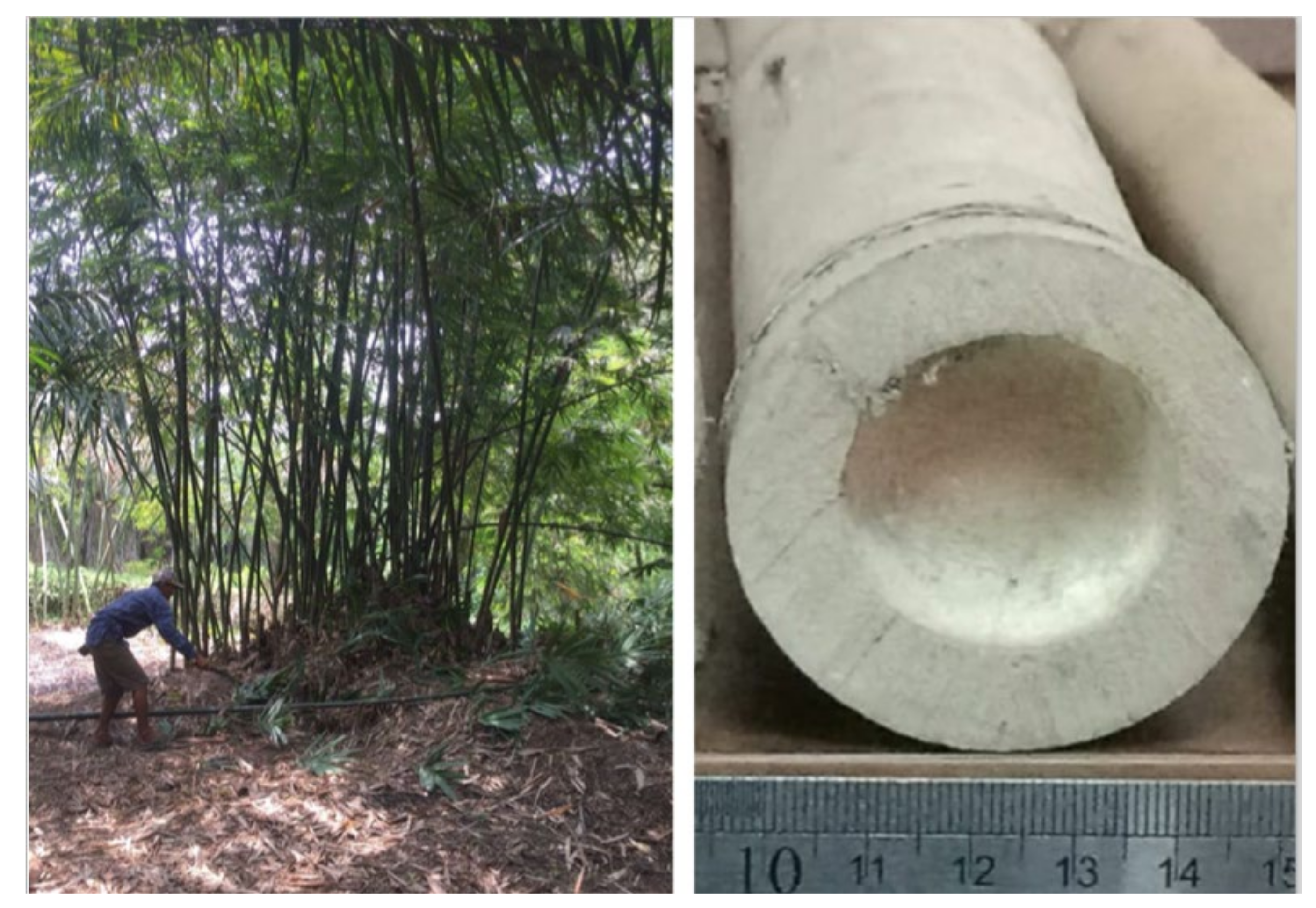


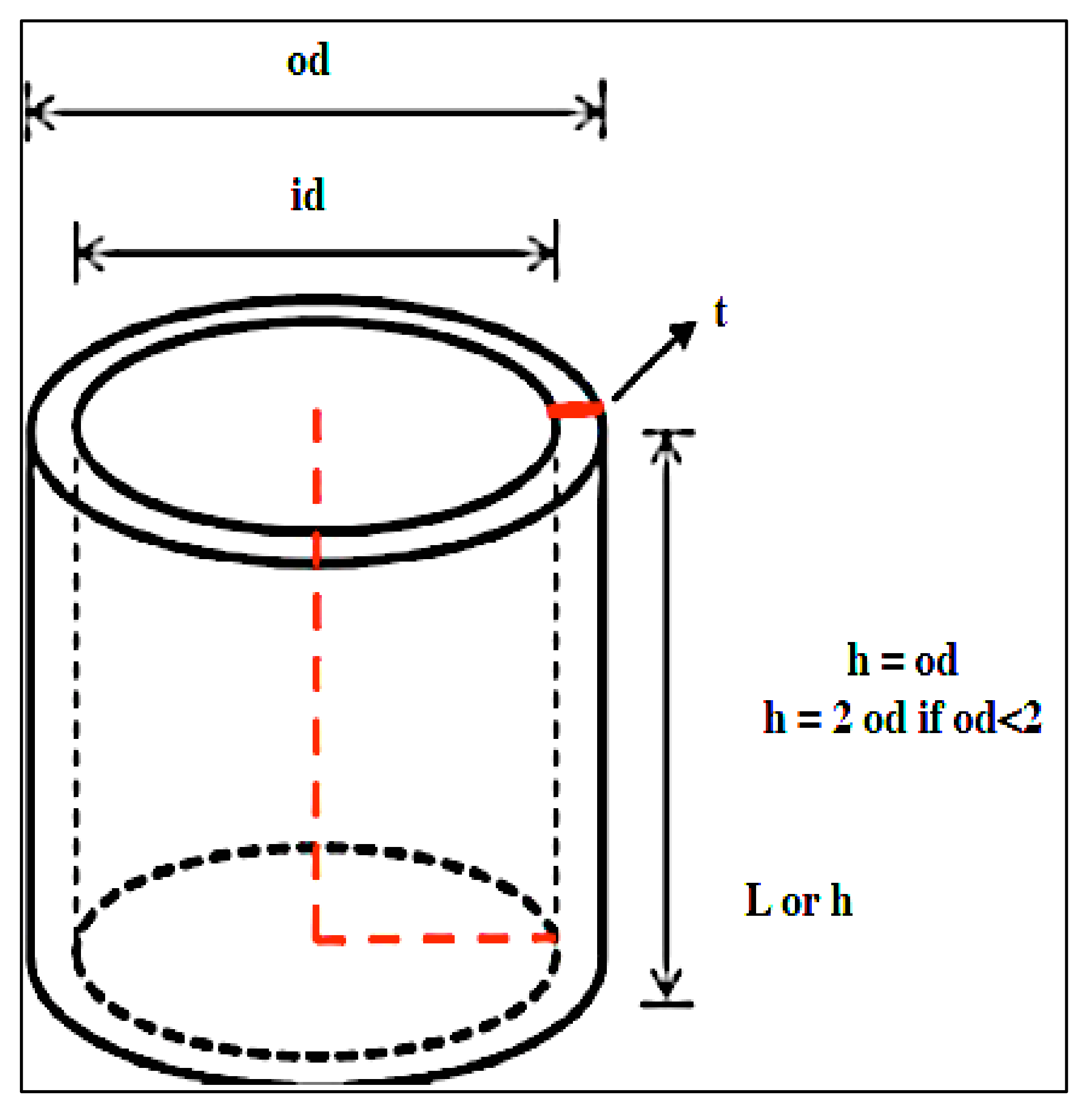



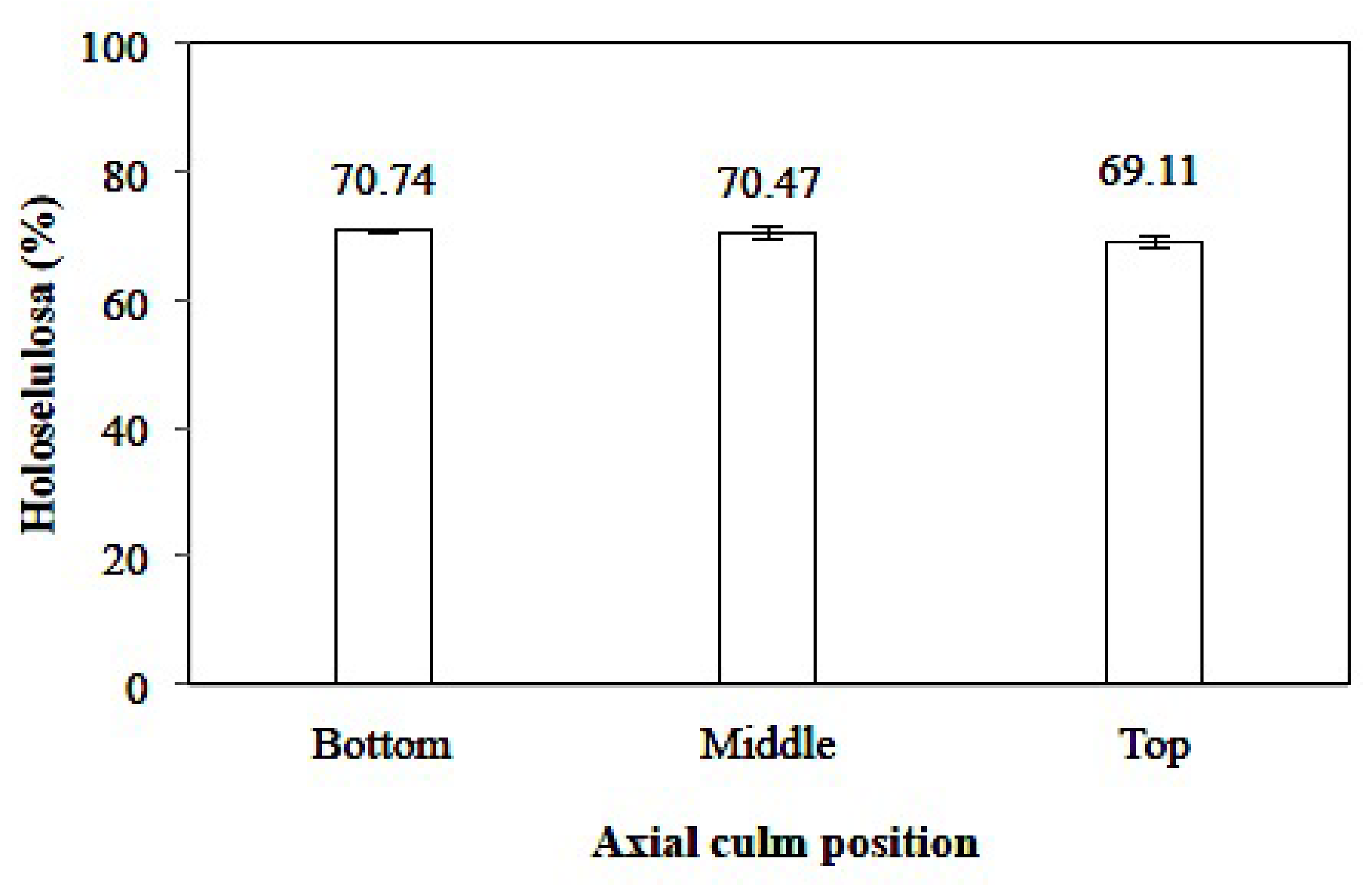

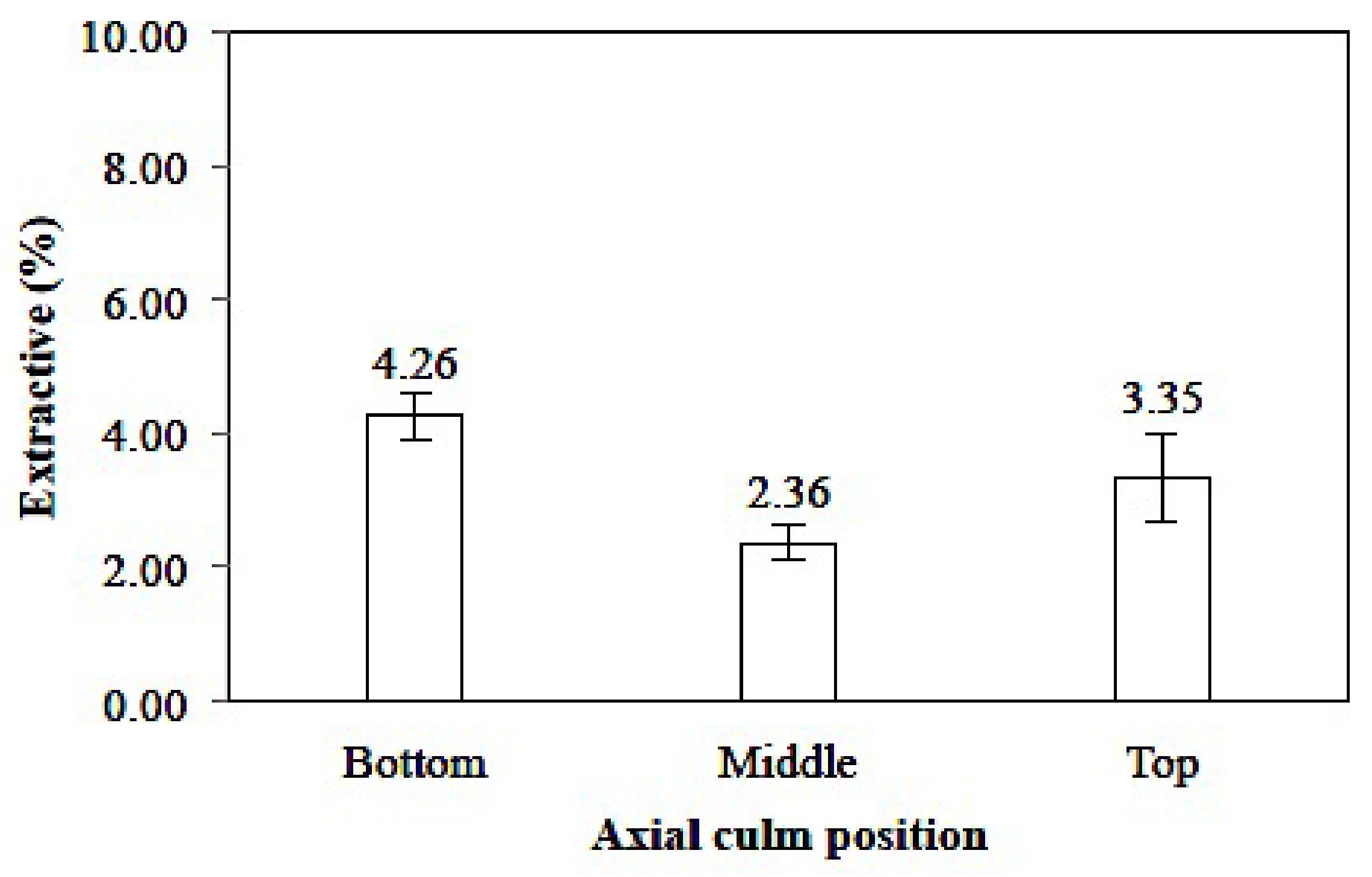
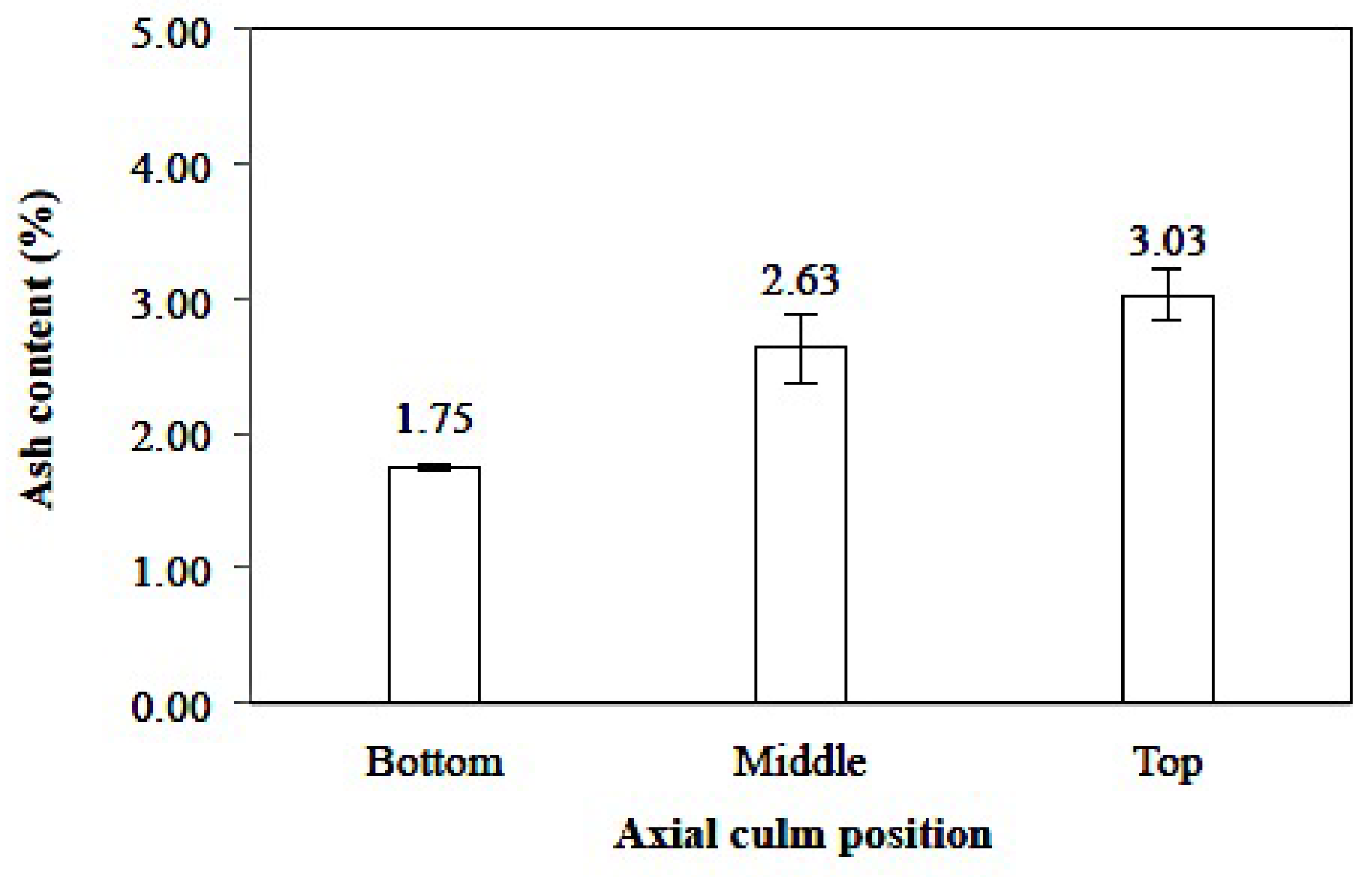


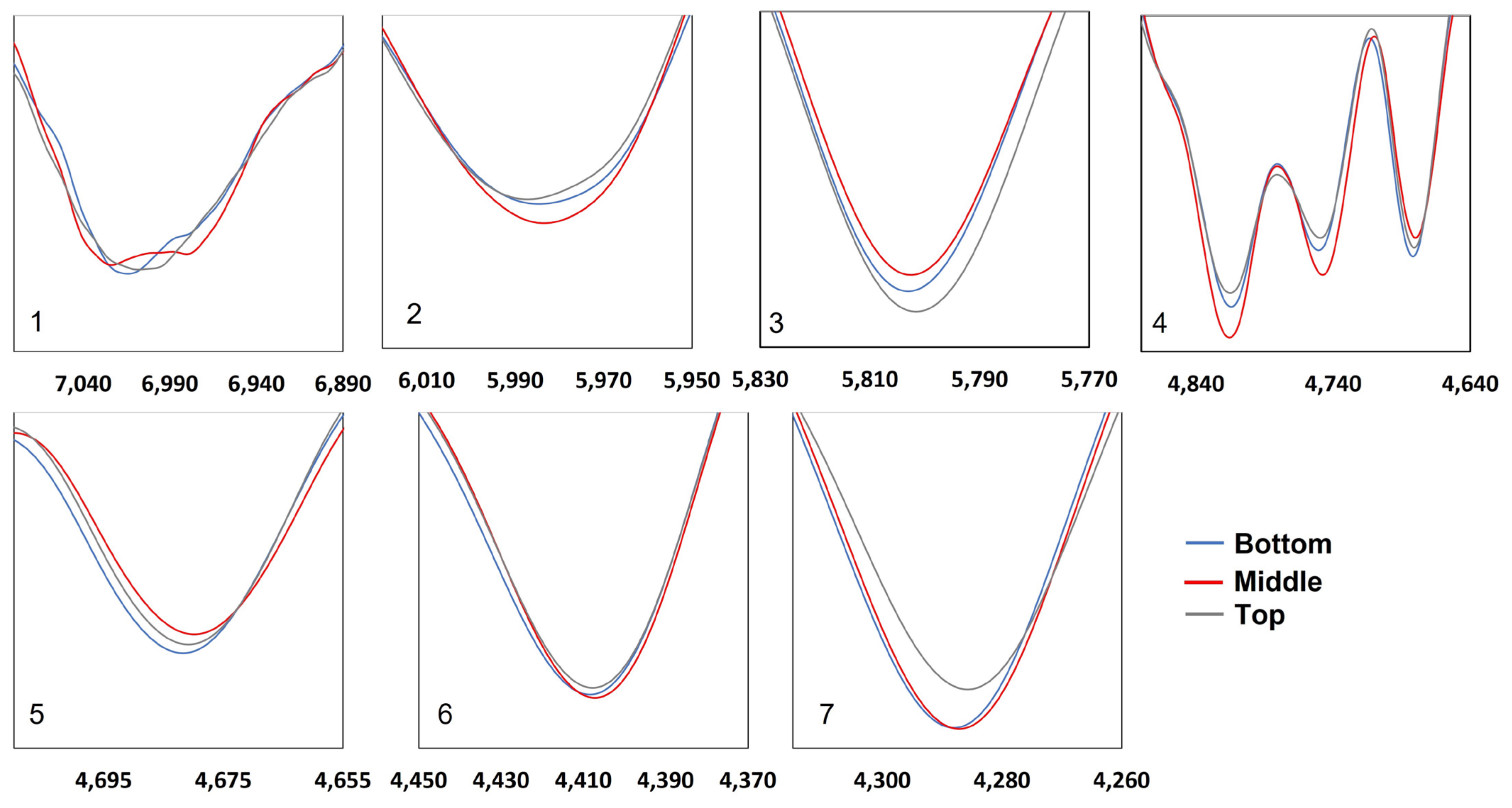
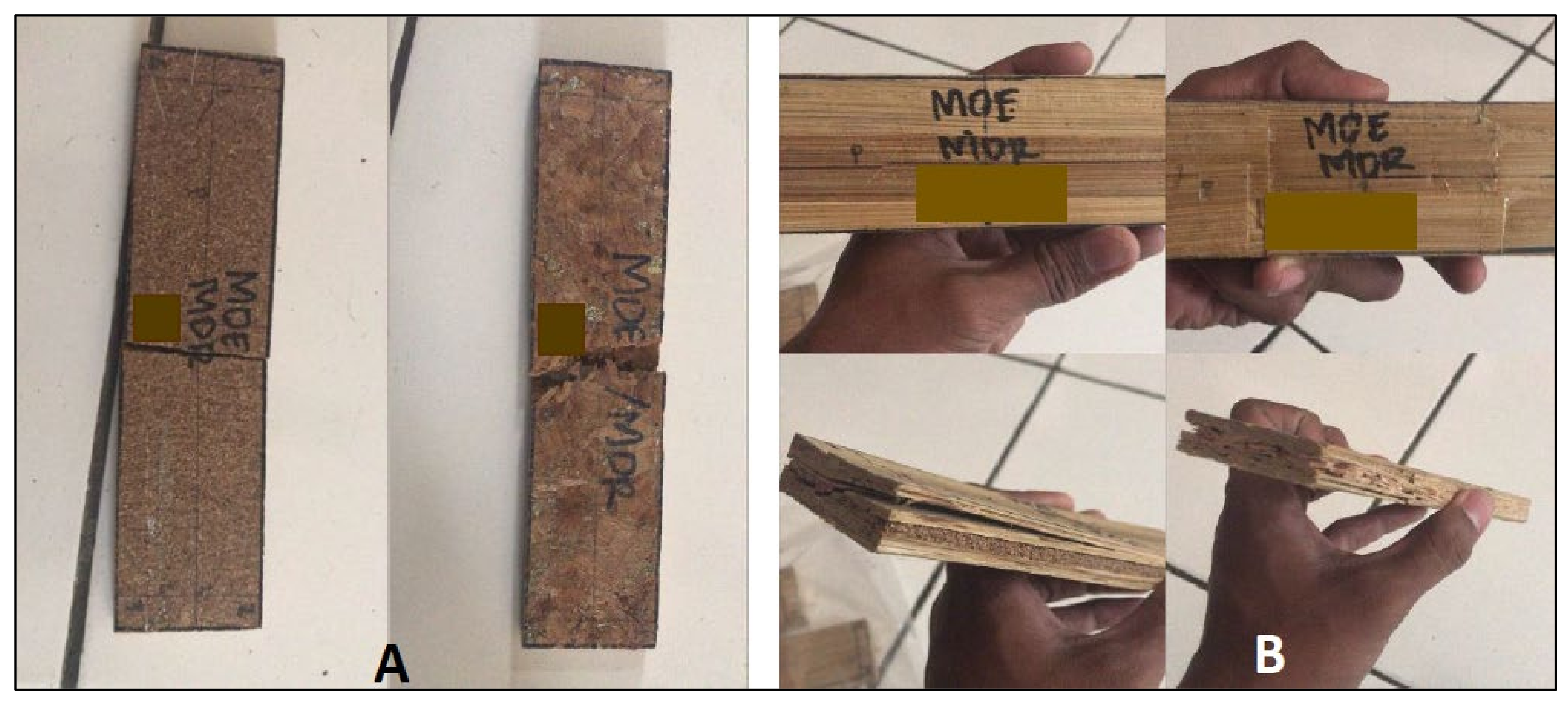
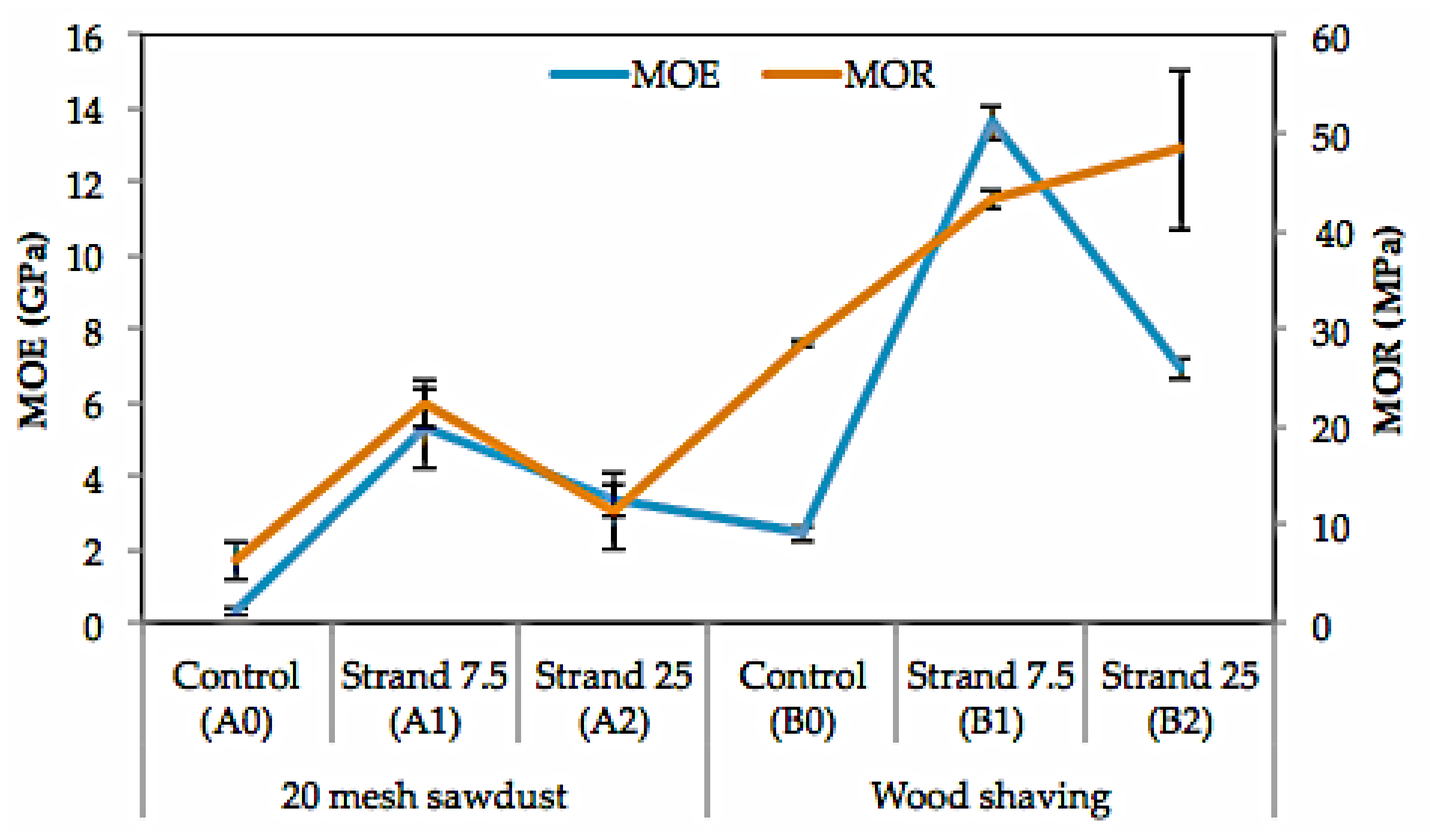
| Particle Type | Length (cm) * | Width (cm) * | Thickness (cm) * | Mesh | Slenderness Ratio |
|---|---|---|---|---|---|
| Sawdust | - | - | - | 20 | - |
| Shaving | 35.26 (11.44) | 18.66 (5.76) | 0.14 (1.08) | N/A | 252.02 (35.09) |
| Strand 7.5 cm | 7.50 (0.03) | 2.51 (0.03) | 0.13 (0.02) | N/A | 62.52 (8.25) |
| Strand 25 cm | 25.34 (0.19) | 2.79 (0.40) | 0.09 (0.25) | N/A | 297.69 (91.73) |
| Properties | Information |
|---|---|
| Solids content | 98% |
| Viscosity | 150–250 cps/23 °C |
| pH | 6.5–8.5 |
| Pot life mixture | Within 60 min |
| Spread volume | 200~250 g/m2 |
| Assembly time | Within 10 min |
| Cold press for a low-density wood | 0.69–0.98 MPa |
| Cold press for a high-density wood | 0.98–1.47 MPa |
| Press time Cold Press | 30–45 min depends on wood species, size of lamella, temperature, and spread volume |
| No | Specification | |
|---|---|---|
| 1 | Height | 160 cm |
| 2 | Length | 90 cm |
| 3 | Width | 50 cm |
| 4 | Pressure plate area | 35 × 35 cm2 |
| 5 | Maximum hydraulic pressure | 20.59 MPa |
| 6 | Hydraulic lifting | 100 ton |
| 7 | Maximum heating power | 2 × 3000 watt |
| 8 | Maximum temperature | 250 °C |
| Parameter | Size |
|---|---|
| Density | 10 cm (length) × 10 cm (width) |
| Moisture content (MC) | 10 cm (length) × 10 cm (width) |
| Water absorption (WA) | 5 cm (length) × 5 cm (width) |
| Thickness swelling (TS) | 5 cm (length) × 5 cm (width) |
| Modulus of elasticity (MOE) | 20 cm (length) × 5 cm (width) |
| Modulus of rupture (MOR) | 20 cm (length) × 5 cm (width) |
| Internal bond (IB) | 5 cm (length) × 5 cm (width) |
| Sample | Fc (kcps.deg) | Fa (kcps.deg) | Xc% |
|---|---|---|---|
| Bottom | 22.8276 | 46.5733 | 32.89 |
| Middle | 41.598 | 68.0017 | 37.95 |
| Top | 26.567 | 62.6533 | 29.78 |
| Physical Properties | Bottom | Middle | Top |
|---|---|---|---|
| Specific gravity | 0.60 (0.08) | 0.58 (0.03) | 0.60 (0.03) |
| Outer Diameter Shrinkage (%) | 2.33 (0.45) | 1.29 (0.45) | 2.33 (0.10) |
| Inner Diameter Shrinkage (%) | 1.94 (0.62) | 0.94 (0.62) | 3.67 (0.14) |
| Linear Shrinkage (%) | 0.13 (0.07) | 0.2 (0.04) | 0.21 (0.09) |
| Mechanical Properties | Bottom | Middle | Top |
|---|---|---|---|
| Compression Strength (MPa) | 45.44 (0.66) | 42.15 (6.63) | 38.96 (8.84) |
| Tensile Strength (MPa) | 116.77 (20.90) | 278.74 (15.20) | 95.88 (5.46) |
| Shear Strength (MPa) | 7.39 (0.61) | 7.69 (1.59) | 7.79 (0.94) |
| Parameter | 20 Mesh Sawdust | Wood Shaving | ||||
|---|---|---|---|---|---|---|
| Control (A0) | Strand 7.5 (A1) | Strand 25 (A2) | Control (B0) | Strand 7.5 (B1) | Strand 25 (B2) | |
| Density (kg/m3) | 690 (30) | 640 (30) | 680 (40) | 670 (10) | 670 (30) | 620 (10) |
| MC (%) | 7.96 (0.25) | 7.10 (0.18) | 6.89 (0.37) | 7.10 (0.46) | 6.66 (0.17) | 6.56 (0.30) |
| WA (%) | 47.70 (5.99) | 45.94 (8.83) | 68.41 (6.73) | 21.72 (5.39) | 31.46 (6.72) | 46.12 (3.60) |
| TS (%) | 4.38 (0.77) | 6.50 (1.56) | 7.37 (1.38) | 5.29 (0.86) | 7.01 (1.05) | 9.57 (2.42) |
| MOE (GPa) | 0.32 (0.12) | 5.28 (1.08) | 3.34 (0.45) | 2.41 (0.19) | 13.63 (0.47) | 6.91 (0.27) |
| MOR (MPa) | 6.39 (1.99) | 22.38 (2.40) | 11.38 (3.88) | 28.52 (0.38) | 43.17 (0.89) | 48.37 (8.19) |
| IB (MPa) | 0.39 (0.09) | 0.19 (0.04) | 0.29 (0.08) | 0.29 (0.04) | 0.15 (0.04) | 0.18 (0.01) |
Publisher’s Note: MDPI stays neutral with regard to jurisdictional claims in published maps and institutional affiliations. |
© 2022 by the authors. Licensee MDPI, Basel, Switzerland. This article is an open access article distributed under the terms and conditions of the Creative Commons Attribution (CC BY) license (https://creativecommons.org/licenses/by/4.0/).
Share and Cite
Iswanto, A.H.; Madyaratri, E.W.; Hutabarat, N.S.; Zunaedi, E.R.; Darwis, A.; Hidayat, W.; Susilowati, A.; Adi, D.S.; Lubis, M.A.R.; Sucipto, T.; et al. Chemical, Physical, and Mechanical Properties of Belangke Bamboo (Gigantochloa pruriens) and Its Application as a Reinforcing Material in Particleboard Manufacturing. Polymers 2022, 14, 3111. https://doi.org/10.3390/polym14153111
Iswanto AH, Madyaratri EW, Hutabarat NS, Zunaedi ER, Darwis A, Hidayat W, Susilowati A, Adi DS, Lubis MAR, Sucipto T, et al. Chemical, Physical, and Mechanical Properties of Belangke Bamboo (Gigantochloa pruriens) and Its Application as a Reinforcing Material in Particleboard Manufacturing. Polymers. 2022; 14(15):3111. https://doi.org/10.3390/polym14153111
Chicago/Turabian StyleIswanto, Apri Heri, Elvara Windra Madyaratri, Nicko Septuari Hutabarat, Eka Rahman Zunaedi, Atmawi Darwis, Wahyu Hidayat, Arida Susilowati, Danang Sudarwoko Adi, Muhammad Adly Rahandi Lubis, Tito Sucipto, and et al. 2022. "Chemical, Physical, and Mechanical Properties of Belangke Bamboo (Gigantochloa pruriens) and Its Application as a Reinforcing Material in Particleboard Manufacturing" Polymers 14, no. 15: 3111. https://doi.org/10.3390/polym14153111
APA StyleIswanto, A. H., Madyaratri, E. W., Hutabarat, N. S., Zunaedi, E. R., Darwis, A., Hidayat, W., Susilowati, A., Adi, D. S., Lubis, M. A. R., Sucipto, T., Fatriasari, W., Antov, P., Savov, V., & Hua, L. S. (2022). Chemical, Physical, and Mechanical Properties of Belangke Bamboo (Gigantochloa pruriens) and Its Application as a Reinforcing Material in Particleboard Manufacturing. Polymers, 14(15), 3111. https://doi.org/10.3390/polym14153111












